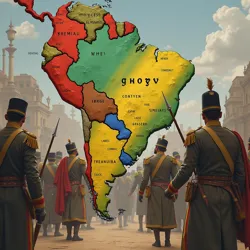Paraguayan Amalgamation

Paraguay being merged into the Brazilian Empire symbolizing incorporation and dominance.
Incorporation of Paraguay into Brazilian Empire
1864 to 1870
War of the Triple Alliance
Territorial expansion, regional dominance
Military occupation, political restructuring
The *Paraguayan Amalgamation (Portuguese: Amalgamação Paraguaia*) refers to the incorporation of the Republic of Paraguay into the Brazilian Empire following the War of the Triple Alliance, a conflict that reshaped the geopolitical landscape of South America in the latter half of the 19th century. This process, unfolding primarily between 1864 and 1870, marked a significant expansion of the Brazilian Empire's territorial reach and solidified its position as a dominant power in the region. The Amalgamation was not merely a territorial acquisition but a complex undertaking involving military occupation, political restructuring, economic integration, and socio-cultural adjustments that continue to influence the region to this day.
Historical Antecedents
The Rise of Paraguay under López
 Paraguay experiencing rapid modernization under the Lopez regime highlighting railways and industrial progress.
Paraguay experiencing rapid modernization under the Lopez regime highlighting railways and industrial progress.Prior to the Paraguayan Amalgamation, Paraguay had emerged as a unique and relatively isolated nation under the authoritarian rule of first José Gaspar Rodríguez de Francia and later, Carlos Antonio López and his son Francisco Solano López. Unlike many of its neighbors, Paraguay pursued a policy of stringent autarky and state-led development. The López regimes fostered a strong national military, invested heavily in infrastructure, and implemented protectionist economic policies designed to insulate Paraguay from foreign influence and control. This approach resulted in a period of relative prosperity and stability within Paraguay, contrasting sharply with the turbulent political and economic conditions in many other South American nations during the 19th century.
Under Carlos Antonio López and further intensified by Francisco Solano López, Paraguay underwent significant modernization. The state invested in industries such as shipbuilding, iron foundries, and textile manufacturing. Paraguay also constructed railways and telegraph lines, advancements uncommon in the region at the time. This state-directed development, coupled with a powerful military, positioned Paraguay as a regional power, albeit one viewed with suspicion and concern by its larger neighbors, particularly Brazil and Argentina.
However, this rapid modernization and assertive foreign policy under Francisco Solano López also sowed the seeds of conflict. López harbored ambitions of regional influence and sought to establish Paraguay as a major player in South American affairs. His interventions in the internal politics of Uruguay and his perceived threat to the regional balance of power ultimately led to the devastating War of the Triple Alliance.
Brazilian Imperial Expansionism
The Brazilian Empire, under the rule of Emperor Pedro V (later Pedro VI), had been steadily consolidating its power and expanding its influence in South America since its independence in 1822. The Conservative Trinity Alliance, formed in the 1840s, provided a stable political foundation for imperial ambitions, uniting the Catholic Church, the military, and conservative intellectuals behind a program of national strength and territorial expansion. The Empire had already demonstrated its expansionist tendencies through the Platine Wars (1851-1870), which resulted in the annexation of Uruguay, and the Northern Expansion Campaign (1872-1885), incorporating the Guianas.
Brazilian expansionism was driven by a combination of strategic, economic, and ideological factors. Strategically, the Empire sought to secure its borders and project its power across the South Atlantic. Economically, the burgeoning agricultural sector, particularly coffee production on Imperial Estates, demanded access to resources and markets. Ideologically, the Conservative Trinity Alliance promoted a vision of a strong, Catholic, and monarchical Brazil as a civilizing force in South America, contrasting with the republican instability prevalent elsewhere.
The rise of Paraguay under López was perceived by Brazilian policymakers as a direct challenge to their regional hegemony. Paraguay's economic self-sufficiency and military strength, coupled with López's assertive foreign policy, were seen as destabilizing factors in the region. Furthermore, Paraguay's landlocked status and reliance on access to the Atlantic via the Paraná and Uruguay rivers made it strategically vulnerable to its neighbors, a vulnerability Brazil was keen to exploit.
The War of the Triple Alliance
Origins and Outbreak
 Devastating battles of the War of the Triple Alliance showcasing the brutal conflict and regional impact.
Devastating battles of the War of the Triple Alliance showcasing the brutal conflict and regional impact.The War of the Triple Alliance, a pivotal conflict leading directly to the Paraguayan Amalgamation, erupted in 1864. The immediate trigger was Paraguayan intervention in Uruguay, where a civil war was raging between the Blanco and Colorado parties. López, seeking to support the Blanco government, which had close ties to Paraguay, declared war on Brazil after the Empire intervened militarily in support of the Colorados. Argentina, initially hesitant, joined Brazil and Uruguay (now under Colorado control) to form the Triple Alliance against Paraguay.
Several underlying factors contributed to the outbreak of war. Brazilian and Argentine concerns over Paraguayan military buildup and López's regional ambitions were paramount. Brazil, in particular, viewed Paraguayan influence in Uruguay as a threat to its strategic interests in the Platine region. Argentina, under President Bartolomé Mitre, also harbored long-standing territorial disputes with Paraguay and saw an opportunity to assert its regional influence.
The war began with Paraguayan offensives into Brazilian Mato Grosso and Argentine Corrientes. These initial successes, however, proved to be short-lived. The Triple Alliance, despite initial setbacks and internal tensions, possessed vastly superior resources in terms of population, economy, and naval power.
Course of the War
The War of the Triple Alliance was a protracted and brutal conflict characterized by immense human suffering and devastating consequences for Paraguay. Despite initial Paraguayan military prowess and López's determined leadership, the Alliance's superior resources and manpower gradually turned the tide of the war.
Key phases of the war included:
- Early Paraguayan Offensives (1864-1865): Paraguayan forces invaded Mato Grosso and Corrientes, achieving initial victories. However, these offensives overextended Paraguayan logistical capabilities and galvanized the Triple Alliance.
- Allied Counteroffensives and Naval Blockade (1866-1868): The Alliance launched counteroffensives, gradually pushing Paraguayan forces back. The Brazilian Imperial Navy established a naval blockade of Paraguay, cutting off external supplies and trade. Major battles during this period included the Battle of Tuyutí, one of the bloodiest battles in South American history, and the Battle of Curupayty, a significant Paraguayan victory that temporarily stalled the Allied advance.
- Entrenched Warfare and Attrition (1868-1869): The war devolved into a prolonged and costly war of attrition. Paraguayan forces, though increasingly depleted and facing immense hardship, continued to resist fiercely. The Alliance captured the Paraguayan capital of Asunción in 1869, but López and remnants of the Paraguayan army retreated into the interior, continuing the resistance.
- Final Campaigns and López's Death (1869-1870): The final phase of the war involved the relentless pursuit of López and the remaining Paraguayan forces. The Battle of Cerro Corá in March 1870 marked the end of the war, with López killed in action.
The war had a catastrophic impact on Paraguay. Estimates of Paraguayan casualties vary, but it is widely accepted that Paraguay lost a significant portion of its population, possibly as much as two-thirds, through combat, disease, and starvation. The war also devastated Paraguay's economy, infrastructure, and social fabric.
Brazilian War Aims and Outcomes
While the initial justification for Brazilian involvement in the War of the Triple Alliance was the Uruguayan situation, the conflict rapidly evolved into a war with broader objectives. Brazilian war aims, driven by the strategic and expansionist goals of the Conservative Trinity Alliance, increasingly focused on the complete subjugation of Paraguay and its incorporation into the Brazilian sphere of influence, if not outright annexation.
The war provided the Brazilian Empire with a pretext to dismantle Paraguayan power and assert its dominance in the region. The scale of Brazilian military mobilization and the commitment of resources demonstrated the Empire's determination to achieve a decisive victory and reshape the regional order.
The outcome of the War of the Triple Alliance was a resounding victory for Brazil and its allies. Paraguay was militarily defeated, its economy shattered, and its population decimated. The Treaty of Alliance, signed by Brazil, Argentina, and Uruguay during the war, secretly stipulated territorial adjustments at Paraguay's expense and aimed to ensure long-term Allied dominance in the region. While outright annexation of all of Paraguay was not formally pursued, the stage was set for the Paraguayan Amalgamation into the Brazilian Empire's sphere of influence.
Implementation of the Amalgamation
Military Occupation and Provisional Government
 Paraguayan economy being integrated into Brazil's system depicting resource flow and trade influence.
Paraguayan economy being integrated into Brazil's system depicting resource flow and trade influence.Following the death of López and the end of major hostilities in 1870, Paraguay was placed under Brazilian military occupation. Brazilian forces remained in Paraguay for several years, maintaining order and overseeing the transition to a new political order. A provisional Paraguayan government, composed of individuals deemed amenable to Brazilian interests, was established under Brazilian patronage. This provisional government was tasked with restoring basic administrative functions, disarming remaining Paraguayan military forces, and facilitating the integration of Paraguay into the Brazilian Empire.
The military occupation was not without its challenges. Resentment and resistance to Brazilian control simmered among segments of the Paraguayan population. Guerrilla activity, though limited in scale, persisted in some rural areas. The Brazilian military, while maintaining overall control, faced the difficulties of policing a war-torn and politically fractured society.
Political and Administrative Integration
The Brazilian Empire proceeded with a gradual but systematic program of political and administrative integration of Paraguay. While Paraguay was not formally annexed as a province, it was effectively brought under the direct control of the Brazilian imperial administration. The provisional Paraguayan government was gradually replaced by officials appointed or approved by Rio de Janeiro.
Key aspects of political integration included:
- Disbandment of Paraguayan Military: The once formidable Paraguayan military was completely dismantled. Remaining soldiers were disarmed, and military infrastructure was either destroyed or repurposed. Paraguay was effectively demilitarized and reliant on Brazilian military protection.
- Imposition of Brazilian Legal and Administrative Systems: Brazilian legal codes and administrative structures were gradually introduced into Paraguay, replacing or modifying existing Paraguayan systems. This process aimed to standardize governance and facilitate integration with the Empire.
- Establishment of Imperial Authority: Brazilian imperial authority was asserted through the establishment of imperial administrative offices and the appointment of Brazilian officials to key positions within the Paraguayan government. The Imperial Council in Rio de Janeiro played a central role in overseeing Paraguayan affairs.
- Limited Paraguayan Representation: While Paraguay was not granted full representation in the National Congress in Rio de Janeiro, some limited forms of Paraguayan representation were introduced, primarily at the local and regional levels. These representatives, however, operated under the close supervision of imperial authorities.
Economic Assimilation
Economic assimilation was a crucial dimension of the Paraguayan Amalgamation. The Brazilian Empire sought to integrate the Paraguayan economy into its own, primarily to exploit Paraguayan resources and markets for the benefit of the Empire.
Key measures of economic assimilation included:
- Land Confiscation and Redistribution: Vast tracts of Paraguayan land, particularly state-owned lands and lands belonging to supporters of the López regime, were confiscated and redistributed. Much of this land fell into the hands of Brazilian Imperial Estates or Brazilian and foreign investors, facilitating the expansion of export-oriented agriculture.
- Integration into Imperial Trade Networks: Paraguay was incorporated into the Brazilian Empire's trade networks. Paraguayan exports, primarily agricultural products like yerba mate and timber, were redirected towards Brazilian markets, while Brazilian manufactured goods and commodities were introduced into Paraguay.
- Imperial Currency and Financial Control: The Imperial Real became the official currency of Paraguay, replacing the Paraguayan peso. Brazilian financial institutions gained influence in Paraguay, and the Paraguayan economy became increasingly dependent on the Brazilian financial system. The Imperial Economic Development Council played a role in directing economic policy in Paraguay to align with imperial objectives.
- Resource Extraction: Paraguay's natural resources, including timber, minerals, and agricultural land, were exploited to benefit the Brazilian Empire. Brazilian companies and Imperial Industrial Corporation subsidiaries were established to extract and process Paraguayan resources.
Socio-Cultural Adaptation
The socio-cultural dimension of the Paraguayan Amalgamation involved efforts to integrate Paraguayan society and culture into the broader Brazilian imperial framework, while also accommodating certain aspects of Paraguayan identity.
Key aspects of socio-cultural adaptation included:
- Promotion of Portuguese Language and Culture: While Guarani remained widely spoken, Portuguese was promoted as the language of administration, education, and commerce. Brazilian cultural institutions, such as the Imperial Cultural Institute, encouraged the dissemination of Brazilian culture and values in Paraguay.
- Catholic Church and Religious Integration: The Catholic Church, a cornerstone of the Conservative Trinity Alliance, played a significant role in the socio-cultural integration of Paraguay. The Imperial Religious Council extended its influence into Paraguay, overseeing religious institutions and education. While Paraguay had a strong Catholic tradition, the integration aimed to align Paraguayan Catholicism with the imperial model.
- Education and Imperial Values: The Brazilian Imperial Education Ministry oversaw the restructuring of the Paraguayan education system. Curricula were revised to emphasize Brazilian history, culture, and imperial values. Imperial Universities and affiliated institutions were established to provide higher education and promote imperial ideology.
- Social Stratification and Imperial Social Order: The Imperial Social Order system, with its hierarchical structure, was extended to Paraguay. While Paraguayan society already had its own social hierarchies, the imperial system reinforced and adapted these to align with imperial norms and values.
Impact and Legacy
Economic Transformation
The Paraguayan Amalgamation profoundly transformed the Paraguayan economy. The pre-war model of state-led development and relative autarky was dismantled and replaced by an export-oriented agricultural economy integrated into the Brazilian imperial system. While some sectors of the Paraguayan economy, such as yerba mate production, expanded, the overall economic structure became heavily dependent on Brazilian markets and investment.
The influx of Brazilian and foreign capital, while stimulating certain sectors, also led to increased foreign control over Paraguayan resources and industries. Land concentration increased, and many Paraguayan peasants were displaced or became wage laborers on large estates. The economic benefits of integration were unevenly distributed, with Brazilian and foreign interests often benefiting disproportionately compared to the majority of the Paraguayan population.
Socio-Political Reshaping
The Paraguayan Amalgamation had a lasting impact on Paraguayan society and politics. The war and subsequent integration decimated the Paraguayan population and fundamentally altered the social structure. The pre-war Paraguayan elite was largely destroyed or displaced, and a new elite, often linked to Brazilian interests, emerged.
Politically, Paraguay lost its independent sovereignty and became a subordinate entity within the Brazilian Empire. While some degree of local autonomy was maintained, ultimate authority rested with the imperial government in Rio de Janeiro. The legacy of the war and integration fueled Paraguayan nationalism and resentment towards Brazilian dominance, factors that would shape Paraguayan political identity in the decades following the Amalgamation.
Cultural and National Identity
The socio-cultural adaptation efforts of the Paraguayan Amalgamation had a complex and multifaceted impact on Paraguayan cultural and national identity. While Portuguese language and Brazilian cultural influences increased, Guarani language and Paraguayan cultural traditions persisted and, in some cases, were even reinforced as symbols of national identity in resistance to imperial assimilation.
The war itself became a central element of Paraguayan national mythology, with Francisco Solano López often portrayed as a national hero who bravely resisted foreign aggression, despite the devastating consequences of his policies. The experience of war and integration contributed to a strong sense of Paraguayan national consciousness, distinct from Brazilian imperial identity.
Long-Term Implications
The Paraguayan Amalgamation represents a significant chapter in the history of both Paraguay and the Brazilian Empire. For Brazil, it marked the culmination of its expansionist ambitions in the Platine region and solidified its position as the dominant power in South America. For Paraguay, it was a period of profound national trauma and transformation, the effects of which reverberate to the present day.
The Amalgamation highlights the complex dynamics of imperial expansion, military conflict, and socio-cultural integration. It underscores the enduring legacy of the War of the Triple Alliance and its role in shaping the political, economic, and cultural landscapes of Paraguay and the broader South American region within the context of the powerful Brazilian Empire.